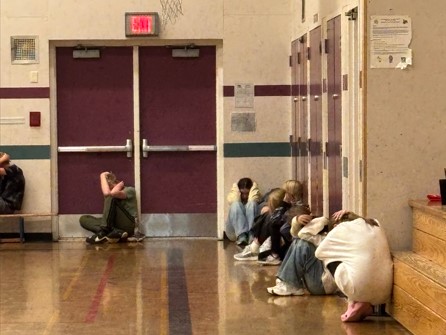By Mandy Moraes, NLPS Staff

As Islanders, we are aware of the safety procedure, “drop, cover, and hold on,” in case of an earthquake. If you grew up here, it’s probably one of the emergency responses you learned as a child in school—right along with fire drills.
However, practice truly does make perfect, and earthquake preparedness training isn’t reserved for school children. An annual province-wide drill known as the ShakeOut, organized by the British Columbia Earthquake Alliance, took place October 16, at 10:16 a.m.
An “earthquake announcement” over school intercoms prompted all staff and students to move away from hazards, drop low to the ground, take cover under sturdy furniture such as a desk or table, hold on until the “shaking” stops, and then wait 60 seconds once it has in case of aftershocks.
Drop, Cover, and Hold On drill is one of Nanaimo Ladysmith Public Schools’ all-hazards responses.
Pleasant Valley Elementary school principal Sara Tyson said there are 12 emergency procedures practiced in a school year, including fire, lockdown, hold and secure, and earthquake drills.
“One of the unique things to be aware of is making sure students understand why we are doing each drill. We don’t want our kids to be afraid, but we want them to be prepared,” Sara Tyson, Principal at Pleasant Valley Elementary.
“Last year, we had a small earthquake, and our students knew to get under their desks right away and start counting. Our teachers reported how impressed they were with their students, as they were able to follow what we do in a drill without prompting,” said Tyson.
In case of a natural disaster or major emergency, the NLPS District Administration Centre will be set up as the Emergency Operations Centre for the school district and will remain in radio communication with schools and transportation to determine what level of emergency response or support is required.
All schools will report to the EOC to notify if there are injuries and if all students and staff are accounted for. In the case of an earthquake, schools report on a post-prioritized earthquake response system that assesses safety for different blocks of the building. The information collected at the EOC would help staff figure out where damage in the district would be. Click here for a video showing the district’s EOC operations.
Emergency preparedness in the school district goes well beyond training.
Through the provincial government’s Seismic Mitigation Program, the school district receives funding for retrofits that help strengthen buildings to withstand earthquakes. Upgrades to schools in the past have included reinforcement to load-bearing walls, joists, and frames, but also work on electrical, air-conditioning, and ventilation systems.
Pete Sabo, the school district’s executive director of planning and operation, said the process to get a school upgraded takes a lot of time and planning.
Schools that are noted as eligible for upgrades by the Ministry of Education and Child Care, through which the program is managed, first need to be added to school district capital plans, prioritized, and then sent back to the ministry for approval.
Once approved, a project definition report is sent back to the ministry, and a design team then considers options for upgrading the school based on the ministry’s review.
Considerations such as how to work around the students and construction planning, Sabo said.
“As an example, if you’re going to insulate your house, you can either tear off all the walls on the inside and insulate it, or you can tear off the exterior walls and insulate it,” he said. “We have a team that evaluates that and comes up with the reasons why.”
Seismically upgraded buildings and drill practice are important for students, but so is ensuring families have a plan in place for earthquakes and emergencies.
Arlen Valade, Senior Health and Safety Manager at NLPS, suggested the Great British Columbia ShakeOut was a good time for parents to review home procedures and emergency supplies — to ensure families have a first-aid kit and enough water, food, heat, and light readily available if electricity is cut off and they need to manage for days without it.
“Also, for parents picking up kids following an emergency, be careful and be patient with our schools, because we must make sure that we are reuniting children with the adults listed on their emergency contact lists,” he said.
The City of Nanaimo has an online 2024 Earthquake and Tsunami Smart Manual, as created by PreparedBC, available at www.nanaimo.ca.
A description of the school district’s emergency procedures is available here.




